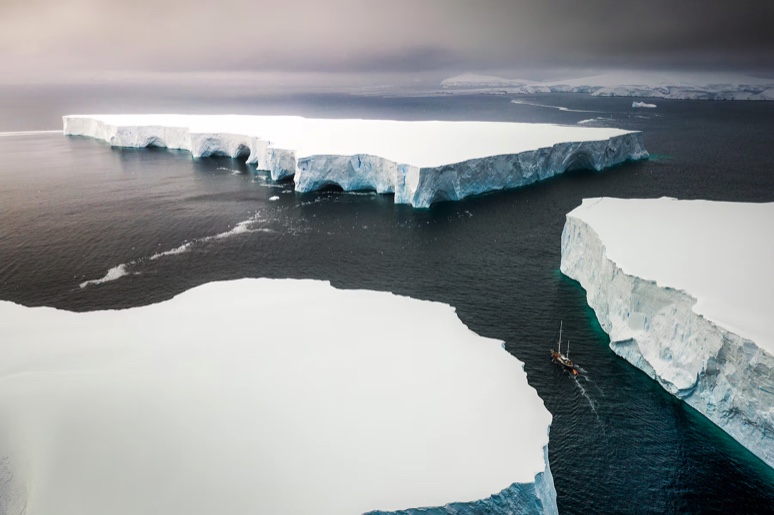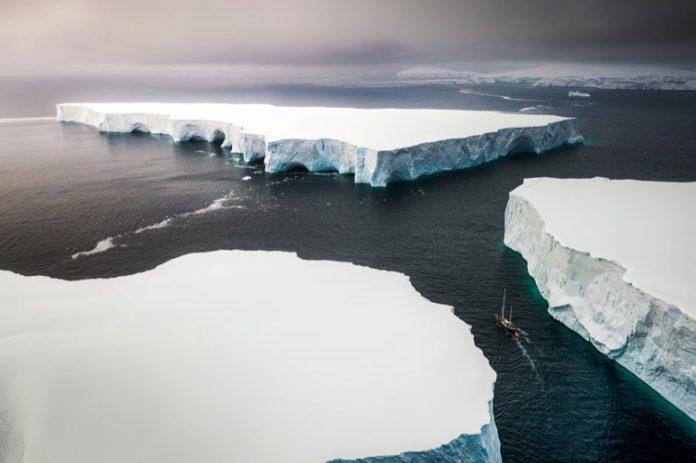การวิจัยใหม่เผยว่าน้ำทะเลกำลังไหลลึกลงไปหลายไมล์ใต้ “Doomsday Glacier” ของทวีปแอนตาร์กติกา ทำให้มีความเสี่ยงต่อการละลายมากขึ้น น้ำเค็มอุ่นๆ นี้ทำให้เกิดการละลายอย่างมาก บ่งชี้ว่าการคาดการณ์การเพิ่มขึ้นของระดับน้ำทะเลอาจถูกประเมินต่ำไป ดังที่รายงานไว้ใน รายงานการประชุมของ National Academy of Sciences ธารน้ำแข็ง Thwaites ซึ่งมีขนาดเทียบได้ประมาณ ฟลอริดา เป็นธารน้ำแข็งที่กว้างที่สุดในโลก ชื่อเล่นว่า “Doomsday Glacier” การพังทลายของธารน้ำแข็งอาจทำให้ระดับน้ำทะเลสูงขึ้นประมาณ 10 ฟุต ก่อให้เกิดภัยคุกคามร้ายแรงต่อชุมชนชายฝั่งทั่วโลก การศึกษาจำนวนมากได้เน้นย้ำถึงช่องโหว่อันใหญ่หลวงของ Thwaites Glacier ผลการศึกษาในปี 2565 ระบุว่าภาวะโลกร้อนที่ขับเคลื่อนโดยมนุษย์จากการเผาเชื้อเพลิงฟอสซิล ทำให้โลกเกาะติด “แค่เล็บมือ” การวิจัยล่าสุดนำเสนอปัจจัยใหม่และน่าตกใจในการคาดการณ์อนาคตของธารน้ำแข็ง
ทีมนักธรณีวิทยานำโดยนักวิทยาศาสตร์จากมหาวิทยาลัยแคลิฟอร์เนีย Irvine ใช้ข้อมูลเรดาร์ดาวเทียมความละเอียดสูงตั้งแต่เดือนมีนาคมถึงมิถุนายนปีที่แล้วเพื่อสร้างรังสีเอกซ์ของธารน้ำแข็ง สิ่งนี้ช่วยให้พวกเขาสามารถติดตามการเปลี่ยนแปลงแนวสายดินของ Thwaites ซึ่งเป็นจุดสำคัญของความเปราะบางต่อความมั่นคงของธารน้ำแข็ง พวกเขาสังเกตเห็นน้ำทะเลที่พลุ่งพล่านอยู่ใต้ธารน้ำแข็งตามกระแสน้ำในแต่ละวัน Eric Rignot ศาสตราจารย์ด้านวิทยาศาสตร์ระบบโลกที่มหาวิทยาลัยแคลิฟอร์เนียที่เออร์ไวน์และผู้ร่วมเขียนการศึกษานี้ แนะนำให้ใช้ “เขตสายดิน (Grounding Zone)” แทน “สายดิน (Grounding Line)” เนื่องจากสามารถเคลื่อนตัวได้เกือบ 4 ไมล์ในรอบกระแสน้ำ 12 ชั่วโมง การเคลื่อนที่อย่างรวดเร็วของน้ำทะเลจะทำให้ธารน้ำแข็งละลายเร็วขึ้น เนื่องจากน้ำจืดจะถูกแทนที่ด้วยน้ำทะเลที่อุ่นกว่าทันทีที่น้ำแข็งละลาย Ted Scambos นักธรณีวิทยาแห่งมหาวิทยาลัยโคโลราโด โบลเดอร์ ยกย่องงานวิจัยนี้ว่า “น่าสนใจและสำคัญ” แม้ว่าเขาจะไม่ได้เกี่ยวข้องก็ตาม เจมส์ สมิธ นักธรณีวิทยาทางทะเลจาก British Antarctic Survey สังเกตถึงความไม่แน่นอนว่ากระแสน้ำทะเลใต้Thwaitesเป็นปรากฏการณ์ที่เกิดขึ้นเมื่อเร็วๆ นี้หรือเป็นปรากฏการณ์ที่มีนัยสำคัญมานานแล้วแต่ไม่มีใครสังเกตเห็น
ในการศึกษาอื่นซึ่งตีพิมพ์เมื่อวันจันทร์เช่นกัน นักวิจัยจาก British Antarctic Survey ได้ตรวจสอบปัจจัยเบื้องหลังระดับน้ำแข็งในทะเลรอบแอนตาร์กติกาเมื่อปีที่แล้วซึ่งต่ำเป็นประวัติการณ์ การละลายของน้ำแข็งในทะเลไม่ได้มีส่วนทำให้ระดับน้ำทะเลเพิ่มขึ้นโดยตรงเนื่องจากน้ำแข็งลอยอยู่แล้ว อย่างไรก็ตาม มันทำให้แผ่นน้ำแข็งชายฝั่งและธารน้ำแข็งสัมผัสกับคลื่นและน้ำทะเลอุ่น ซึ่งเพิ่มความเสี่ยงต่อการละลายและการกระจายตัวของพวกมันอย่างมาก นอกจากนี้ นักวิจัยยังใช้แบบจำลองสภาพภูมิอากาศเพื่อคาดการณ์อัตราการฟื้นตัวจากการสูญเสียน้ำแข็งในทะเลที่รุนแรงนี้ พวกเขาค้นพบว่าแม้หลังจากผ่านไปสองทศวรรษ น้ำแข็งก็ไม่สามารถเติมเต็มได้ทั้งหมด Louise Sime ผู้ร่วมเขียนการศึกษาของ BAS กล่าวในการแถลงข่าวว่าการค้นพบเหล่านี้มีส่วนทำให้เกิดหลักฐานที่บ่งชี้ถึง “การเปลี่ยนแปลงระบอบการปกครองที่ยั่งยืน” ในภูมิภาคในช่วงไม่กี่ปีที่ผ่านมา
Ocean water is flowing deep beneath the ‘Doomsday Glacier,’ which could significantly impact sea level rise.

Ocean water is pushing miles beneath Antarctica’s “Doomsday Glacier,” making it more vulnerable to melting, according to new research. This warm, salty water is causing significant melting, suggesting sea level rise projections might be underestimated, as reported in the Proceedings of the National Academy of Sciences. Thwaites Glacier, roughly the size of Florida, is the world’s widest glacier. Nicknamed the “Doomsday Glacier,” its collapse could raise sea levels by about 10 feet, posing a severe threat to coastal communities worldwide. Many studies have highlighted Thwaites Glacier’s immense vulnerabilities. A 2022 study noted that human-driven global warming, from burning fossil fuels, has left it clinging “by its fingernails.” The latest research introduces a new and alarming factor into projections of the glacier’s future.
A glaciologist team, led by scientists from the University of California, Irvine, utilised high-resolution satellite radar data from March to June last year to create an X-ray of the glacier. This enabled them to track changes to Thwaites’ grounding line, a critical point of vulnerability for the glacier’s stability. They observed seawater surging beneath the glacier, following the daily tides. Eric Rignot, professor of Earth system science at the University of California at Irvine and a co-author on the study, suggested using “grounding zone” instead of “grounding line” as it can shift nearly 4 miles in a 12-hour tidal cycle. The rapid movement of seawater accelerates glacier melt, as freshwater is replaced by warmer seawater as soon as the ice melts. Ted Scambos, a glaciologist at the University of Colorado Boulder, praised the research as “fascinating and important,” although he wasn’t involved. James Smith, a marine geologist at the British Antarctic Survey, echoed this sentiment, noting the uncertainty about whether the seawater rush under Thwaites is a recent phenomenon or has long been significant but unnoticed.
In another study, published on Monday as well, researchers from the British Antarctic Survey examined the factors behind the record-low levels of sea ice surrounding Antarctica last year. The melting of sea ice doesn’t directly contribute to sea level rise since it’s already floating. However, it exposes coastal ice sheets and glaciers to waves and warm ocean waters, significantly increasing their vulnerability to melting and fragmentation. Additionally, the researchers employed climate models to forecast the potential rate of recovery from this extreme sea ice loss. They discovered that even after two decades, not all the ice will replenish. Louise Sime, a co-author of the BAS study, stated in a press release that these findings contribute to the mounting evidence indicating a “lasting regime shift” in the region over the past few years.
By CNN NEWS

















